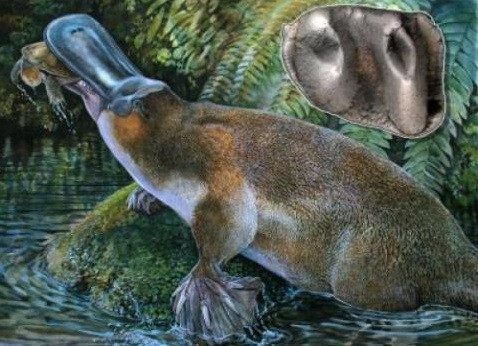Gigantic 'Godzilla' Platypus Fossil Discovered in Australia

A giant extinct species of platypus dubbed platypus-zilla has been discovered in Australia.
Scientists found a single tooth of the huge platypus that lived between 5 and 15 million years ago in the Riversleigh World Heritage Area of northwest Queensland.
The platypus is widely considered the most peculiar animal on the planet and is often called 'God's Joke'. It has a broad duck-like bill, thick fur like an otter and webbed feet like a beaver. It also lays eggs instead of live young unlike other mammals.
The story of how the platypus evolved in Indigenous Australia tells the tale of Tharalkoo, a head-strong duck who often disobeyed her parents.
Her mother and father told her not to swim down river because Bigoon, a Water-rat, would have his wicked way with her. She disobeyed and was attacked by Bigoon.
When she escaped and returned to her family, she laid eggs but instead of a duckling emerging, her offspring had a bill, webbed hind feet and the fur of a rodent.
The discovery of the new platypus-zilla shows that there was a sixth branch to the platypus family tree and that more than one species lived at any one time - it was previously thought that only one species of platypus lived at any one time.
Feasted on turtles
Named Obdurodon tharalkooschild, lead author Rebecca Pian from Columbia University, said the species is "very important" to the understanding of these mammals.
Based on the size of the tooth, researchers estimate the new species would have been around a metre long and about twice the size of a modern platypus. They believe it would have eaten turtles and frogs.
Suzanne Hand, from the University of New South Wales, said: "Like other platypuses, it was probably a mostly aquatic mammal, and would have lived in and around the freshwater pools in the forests that covered the Riversleigh area millions of years ago.
"Obdurodon tharalkooschild was a very large platypus with well-developed teeth, and we think it probably fed not only on crayfish and other freshwater crustaceans, but also on small vertebrates including the lungfish, frogs, and small turtles that are preserved with it in the Two Tree Site fossil deposit."
Previous platypus fossils suggest that over time, the species became smaller and reduced the size of their teeth. Modern platypus have lost their teeth and instead have horny pads in their mouths.
Researcher Michael Archer said: "Discovery of this new species was a shock to us because prior to this, the fossil record suggested that the evolutionary tree of platypuses was a relatively linear one. Now we realise that there were unanticipated side branches on this tree, some of which became gigantic."
© Copyright IBTimes 2025. All rights reserved.






















